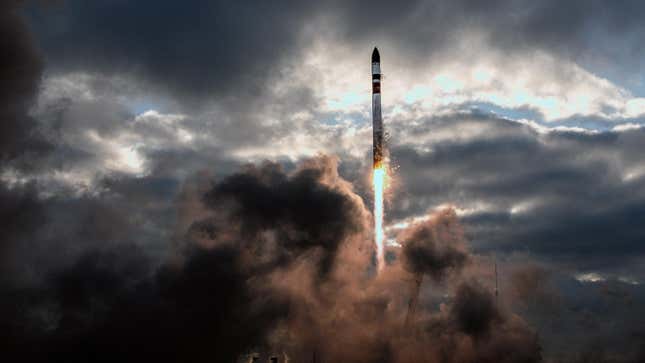Rocket Lab kicked off the year with the launch and recovery of its Electron rocket as part of the company’s continued efforts to reuse its small launch vehicle’s first stage.
Electron lifted off on Wednesday at 1:34 a.m. ET from Rocket Lab’s Launch Complex 1 on New Zealand’s Mahia Peninsula, carrying the first four Space Situational Awareness (SSA) satellites for NorthStar. The rocket deployed the satellites to a 329 mile (530 kilometer) circular Earth orbit, from which they are designed to keep track of objects in space and deliver collision avoidance, navigation, and proximity alert.
The Four Of A Kind mission also saw the Electron rocket’s first stage fall back towards Earth for its latest reusability test. The booster was carried down with the help of a parachute before splashing down in the Pacific Ocean around 17 minutes after liftoff, according to Rocket Lab. The company recovered the rocket booster and is currently analyzing it in order to be able to reuse it for future launches.

Rocket Lab has been experimenting with Electron’s reusability, hoping to inch itself closer to its main industry rival SpaceX. The company had initially come up with a much more daring plan to recover its boosters, catching the rockets with a helicopter mid-air as they descended towards the ocean with the help of a parachute to slow down their speed. The helicopter is then meant to safely transport the boosters to shore. In a disappointing turn of events, Rocket Lab opted to give up on the elaborate, and honestly just super cool, way to recover its boosters after two back-to-back failures.
Both times, the Electron booster was recovered from the ocean. Although the whole point of the mid-air recovery was to prevent the booster from being submerged in the water (to increase its potential for reusability), the rocket did just fine after its swim. So rather than trying to save it from getting wet, Rocket Lab is now studying how to be able to reuse its rocket despite having been submerged in the ocean.
Wednesday’s launch marked Electron’s 43rd mission overall. The company made a comeback with its small launch vehicle in December 2023 following a brief setback when Electron experienced an in-flight anomaly three months earlier. Prior to the rocket failure, Electron had been on a solid streak of 20 consecutive successful launches. The 59-foot-tall (18-meter-tall) light lift launch vehicle is the second most frequently used rocket in the U.S., delivering government and privately owned payloads.
Following its first launch of 2024, Rocket Lab is planning on going big for the rest of the year. “The success of today’s mission to deliver Spire & NorthStar to orbit, and the completion of our secondary mission to return Electron to Earth after launch, has been a fantastic start of what is set to be Rocket Lab’s busiest year ever,” Rocket Lab founder and CEO, Peter Beck, said in a statement. “We have more missions booked in 2024 than we’ve ever scheduled before.”
For more spaceflight in your life, follow us on X (formerly Twitter) and bookmark Gizmodo’s dedicated Spaceflight page.

